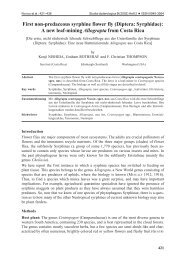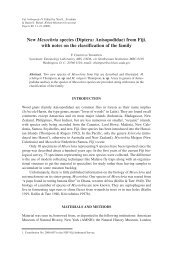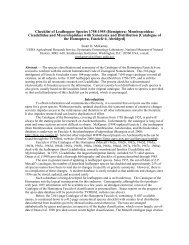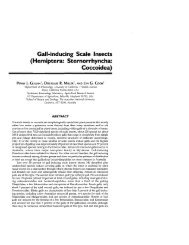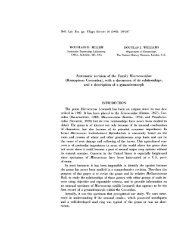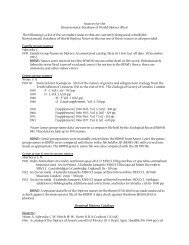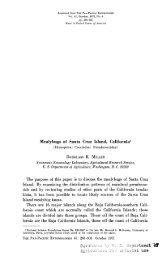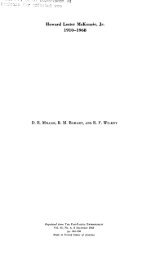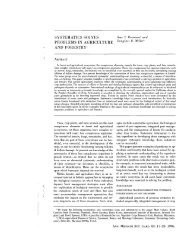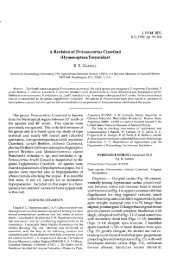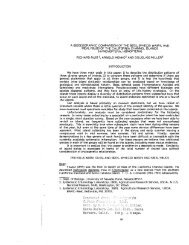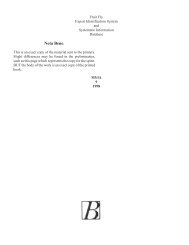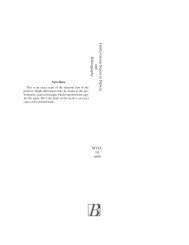A NEW SPECIES OF PUTa AND A PRELIMINARY ANALYSIS OF ...
A NEW SPECIES OF PUTa AND A PRELIMINARY ANALYSIS OF ...
A NEW SPECIES OF PUTa AND A PRELIMINARY ANALYSIS OF ...
Create successful ePaper yourself
Turn your PDF publications into a flip-book with our unique Google optimized e-Paper software.
10 MIllER & MIllER: puro KOSZTARABI<br />
second-instar males, 19 first instars, U.S.A.: In addition to the paratype<br />
associated on the slide with the holotype, there are 61 paratypes on 37<br />
slides (NHM, UCD, USNM, VPI). Complete collection information is<br />
presented in the corresponding "Specimens examined" section for the<br />
adult and immature stages.<br />
Etymology: The species is named in honor of Michael Kosztarab, who<br />
has diligently added to the systematic knowledge of scale insects through<br />
his personal research and the research of his students. This species was<br />
collected by Michael in his quest to better understand the diversity of<br />
insect life in Virginia.<br />
Habitat: Puto kosztarabi is associated with the grass Danthonia<br />
spicata on Buffalo Mountain (elev. 3,972 ft.), Hoyd County, Virginia.<br />
Both mealybug and grass are found near the summit's higher elevations<br />
in unique prairie-like glades that contain magnesium-rich soils. The<br />
Buffalo Mountain site is the only known site of this mealybug. Nine<br />
other similar ecological habitats in Virginia and North Carolina were<br />
examined in 1992 and 1993, but P. kosztarabi was not collected in any<br />
of these other sites (Michael Kosztarab, pers. comm.).<br />
Adult female (fourth instar)<br />
Figure 1<br />
" Slide-mounted characters: Holotype oval, length 2.4 mm, width 1.0<br />
mm; paratypes 3.6 (2.5-4.6) mm, 1.9 (1.4-2.6) mm.<br />
Dorsum: With 21 pairs of cerarii, paratypes 20 (19-21); anal-lobe<br />
cerarius (Fig. 1d) with 29 conical setae, paratypes 29 (26-33) and 46<br />
trilocular pores, paratypes 54 (39-61), without associated discoidal pores<br />
or tubular ducts; frontal cerarius with 19 conical setae, paratypes 22<br />
(18-28) and 13 trilocular pores, paratypes 12 (9-19), without associated<br />
discoidal pores or tubular ducts; all cerarii with basal sclerotization.<br />
Multilocular disc pores absent; trilocular pores (Fig. 1c) scattered;<br />
discoidal pores (Fig. 1b) of 1 size, most abundant along body margin and<br />
on thorax and head. Oral-collar tubular ducts of large size (Fig. 1e)<br />
located near anterior cerarii on dorsal and ventral surface, with 3 ducts<br />
on each side of head, paratypes with 3 (1-7), oral collars absent elsewhere.<br />
Body setae conical (Fig. 1a), usually with basal sclerotization and<br />
associated trilocular pores, often coalesced with other dorsal setae, longest<br />
seta on abdomen 26 j..Im long, paratypes 33 (29-36) j..Im, about same size<br />
as cerariian setae; with 53 setae on segtl)ent V, excluding those in cerarii,<br />
paratypes with 53 (45·59).



